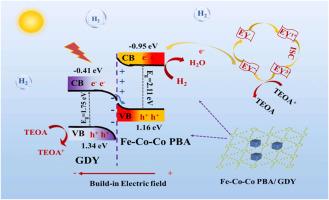3D/2D Fe–Co–Co Prussian blue analogues/graphdiyne S-scheme heterojunctions for broad-spectrum photocatalytic H2 evolution
IF 11.6
2区 材料科学
Q1 CHEMISTRY, PHYSICAL
引用次数: 0
Abstract
Graphdiyne (GDY), a unique carbon allotrope, has emerged as an exceptional photocatalytic material characterized by its wide-spectrum response, and high specific surface area and excellent chemical stability. Nevertheless, its photocatalytic hydrogen evolution (PHE) efficiency is constrained by poor photogenerated carrier separation. In this work, we construct an innovative S-scheme Fe–Co–Co PBA/GDY heterojunction by coupling Fe–Co–Co Prussian blue analogues (Fe–Co–Co PBA) and amorphous GDY nanosheets for enhanced broad-spectrum photocatalytic hydrogen production (PHE). The amorphous GDY nanosheets and Fe–Co–Co PBA with large specific surface area, can provide abundant active sites for proton adsorption. In situ XPS, ESR test and DFT calculations confirm the S-scheme charge transfer mechanism of the Fe–Co–Co PBA/GDY heterojunction. This unique S-scheme architecture capitalizes on the synergistic effects of interfacial built-in electric field and band bending to facilitate efficient spatial charge separation through selective recombination of electrons in GDY with holes in Fe–Co–Co PBA, while preserving the strongest redox potentials by retaining holes in GDY and electrons in Fe–Co–Co PBA. Consequently, the optimized 25 %Fe–Co–Co PBA/GDY composite exhibits an exceptional hydrogen production rate of 2433.89 μmol g−1 h−1, which was 7.23 and 6.18 times enhancements over pristine Fe–Co–Co PBA and GDY. This work demonstrates the great potential of GDY-based S-scheme photocatalyst for high-performance solar-to-hydrogen conversion.

3D/2D Fe-Co-Co普鲁士蓝类似物/石墨炔s -方案异质结用于广谱光催化析氢
石墨二炔(GDY)是一种独特的碳同素异形体,具有广谱响应、高比表面积和优异的化学稳定性等特点,是一种特殊的光催化材料。然而,其光催化析氢(PHE)效率受到光生载流子分离不良的限制。在这项工作中,我们通过将Fe-Co-Co普鲁士蓝类似物(Fe-Co-Co PBA)与无定形GDY纳米片耦合,构建了一种创新的S-scheme Fe-Co-Co PBA/GDY异质结,以增强广谱光催化制氢(PHE)。非晶GDY纳米片和Fe-Co-Co - PBA具有较大的比表面积,可以为质子吸附提供丰富的活性位点。原位XPS、ESR测试和DFT计算证实了Fe-Co-Co PBA/GDY异质结的S-scheme电荷转移机制。这种独特的S-scheme结构利用了界面内置电场和能带弯曲的协同效应,通过GDY中的电子与Fe-Co-Co PBA中的空穴的选择性重组来促进有效的空间电荷分离,同时通过保留GDY中的空穴和Fe-Co-Co PBA中的电子来保持最强的氧化还原电位。结果表明,优化后的25% Fe-Co-Co PBA/GDY复合材料的产氢率为2433.89 μmol g−1 h−1,分别是原始Fe-Co-Co PBA和GDY的7.23倍和6.18倍。这项工作证明了基于gdd的S-scheme光催化剂在高性能太阳能制氢转化方面的巨大潜力。
本文章由计算机程序翻译,如有差异,请以英文原文为准。
求助全文
约1分钟内获得全文
求助全文
来源期刊

Carbon
工程技术-材料科学:综合
CiteScore
20.80
自引率
7.30%
发文量
0
审稿时长
23 days
期刊介绍:
The journal Carbon is an international multidisciplinary forum for communicating scientific advances in the field of carbon materials. It reports new findings related to the formation, structure, properties, behaviors, and technological applications of carbons. Carbons are a broad class of ordered or disordered solid phases composed primarily of elemental carbon, including but not limited to carbon black, carbon fibers and filaments, carbon nanotubes, diamond and diamond-like carbon, fullerenes, glassy carbon, graphite, graphene, graphene-oxide, porous carbons, pyrolytic carbon, and other sp2 and non-sp2 hybridized carbon systems. Carbon is the companion title to the open access journal Carbon Trends. Relevant application areas for carbon materials include biology and medicine, catalysis, electronic, optoelectronic, spintronic, high-frequency, and photonic devices, energy storage and conversion systems, environmental applications and water treatment, smart materials and systems, and structural and thermal applications.
 求助内容:
求助内容: 应助结果提醒方式:
应助结果提醒方式:


